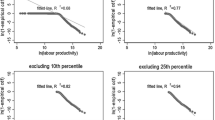Abstract
In a recent paper Helpman, Melitz and Yeaple argue firm heterogeneity leads to self-selection in the structure of international commerce. Only the most productive firms find it profitable to meet the higher costs associated with FDI; the next set of firms finds it profitable to serve foreign markets through exporting; while the least productive firms serve only the domestic market. The paper tests this assumption using the concept of stochastic dominance. Robust support is found for the model, the productivity distribution of multinational firms is found to dominate that of export firms, which in turn dominates that of non-exporters.
Similar content being viewed by others
References
Aitken, B., G. H. Hanson, and A. E. Harrison (1997). Spillovers, Foreign Investment, and Export Behavior. Journal of International Economics 43 (1–2): 103–132.
Aw, B. Y., S. Chung, and M. J. Roberts (2000). Productivity and Turnover in the Export Market: Micro-Level Evidence from the Republic of Korea and Taiwan (China). The World Bank Economic Review 14 (1): 65–90.
Baldwin, J. R., and W. Gu (2003). Participation on Export Markets and Productivity Performance in Canadian Manufacturing. Canadian Journal of Economics 36 (3): 634–657.
Bernard, A., and J. B. Jensen (1999). Exceptional Exporters Performance: Cause, Effect or Both? Journal of International Economics 47 (1): 1–25.
Bernard, A. B., and C. I. Jones (1996). Comparing Apples to Oranges: Productivity Convergence and Measurement across Industries and Countries. American Economics Review 86 (5): 1216–1252.
Bernard, A. B., and J. Wagner (1997). Exports and Success in German Manufacturing. Review of World Economics/Weltwirtschaftliches Archiv 133 (1): 134–157.
Bernard, A., J. Eaton, B. Jensen, and S. Kortum (2003). Plants and Productivity in International Trade. American Economic Review 93 (4): 1268–1290.
Blonigen, B. (2001). In Search of Substitution Between Foreign Production and Exports. Journal of International Economics 53 (1): 81–104.
Brainard, S. L. (1997). An Empirical Assessment of the Proximity-Concentration Trade-Off Between Multinational Sales and Trade. American Economic Review 87 (4): 520–544.
Carree, M. A., L. Klomp, and A. R. Thurik (2000). Productivity Convergence in OECD Industries. Economic Letters 66 (3): 337–345.
Castellani, D. (2002). Export Behaviour and Productivity Growth: Evidence from Italian Manufacturing Firms. Review of World Economics/Weltwirtschaftliches Archiv 138 (4): 605–628.
Caves, D. W., L. R. Christensen, and W. E. Diewert (1982). Multilateral Comparisons of Output, Input, and Productivity Using Superlative Index Numbers. Economic Journal 92 (365): 73–86.
Choi, J. P., and C. Davidson (2004). Strategic Second Sourcing by Multinationals. International Economic Review 45 (2): 579–600.
Clausing, K. A. (2000). Does Multinational Activity Displace Trade? Economic Inquiry 38 (2): 190–205.
Conover, W. J. (1999). Practical Nonparametric Statistics. New York: John Wiley & Sons.
Conyon, M. J., S. Girma, S. Thompson, and P. W. Wright (2002). The Productivity and Wage Effects of Foreign Acquisition in the United Kingdom. Journal of Industrial Economics 50 (1): 85–102.
Delgado, M. A., J. C. Farinas, and S. Ruano (2002). Firms’ Productivity and Export Markets: A Non-Parametric Approach. Journal of International Economics 57 (2): 397–422.
Girma, S., H. Görg, and E. Strobl (2004). Exports, International Investment, and Plant Performance: Evidence from a Non-Parametric Test. Economics Letters 83 (3): 317–324.
Girma, S., D. Greenaway, and R. Kneller (2004). Does Exporting Lead to Better Performance? A Microeconometric Analysis of Matched Firms. Review of International Economics 12 (2): 855–866.
Görg, H., and D. Greenaway (2004). Much Ado About Nothing? Do Domestic Firms Really Benefit from Foreign Direct Investment? World Bank Research Observer 19 (2): 171–197.
Graham, E. M. (2000). The Relationships between Trade and Foreign Direct Investment in the Manufacturing Sector: Empirical Results for the United States and Japan. In D. Encarnation (ed.). Does Ownership Matter? Japanese Multinationals in East Asia. London: Oxford University Press.
Greenaway, D., and R. Kneller (2004). Exporting, Productivity and Agglomeration: A Matched Difference in Difference Analysis of Matched Firms. GEP Research Paper 03/45. Leverhulme Centre for Research on Globalisation and Economic Policy, University of Nottingham.
Greenaway, D., N. Sousa, and K. Wakelin (2004). Do Domestic Firms Learn to Export from Multinationals? European Journal of Political Economy 20 (4): 1027–1043.
Good, D. H., M. I. Nadiri, and R. C. Sickles (1995). Index Number and Factor Demand Approaches to the Estimation of Productivity. In M. Hashem Pesaran and P. Schmidt (eds.), Handbook of Applied Econometrics. Vol. 2. Oxford: Blackwell Publishers.
Harris, R., and C. Robinson (2002). The Effect of Foreign Acquisitions on Total Factor Productivity: Plant-Level Evidence from U.K. Manufacturing, 1987–1992. Review of Economics and Statistics 84 (3): 562–568.
Head, K., and J. Ries (2003a). Heterogeneity and the Foreign Direct Investment versus Exports Decision of Japanese Manufacturers. Journal of the Japanese and International Economies 17: 448–467.
Head K., and J. Ries (2003b). Overseas Investment and Firm Exports. Review of International Economics 9 (1): 108–122.
Helpman, E., M. Melitz, and S. Yeaple (2004). Export versus FDI with Heterogeneous Firms. American Economic Review 94 (1): 300–316.
Lipsey, R. E. and M. Y. Weiss (1984). Foreign Production and the Exports of Individual Firms. Review of Economics and Statistics 66 (3): 340–307.
Maddison, A. (2001). The World Economy: A Millennial Perspective. Paris: OECD.
Melitz, M. (2003). The Impact of Trade on Intra-Industry Reallocations and Aggregate Industry Productivity. Econometrica 71 (6): 1695–1725.
Obstfeld, M., and A. Taylor (2003). Global Capital Markets: Integration, Crisis and Growth. Cambridge: Cambridge University Press.
Oulton, N. (1998). Competition and the Dispersion of Labour Productivity amongst UK Companies. Oxford Economic Papers 50 (1): 23–38.
Sprent, P. (1989). Applied Nonparametric Statistical Methods. London: Chapman and Hall.
Togo, F. (2002). Productivity Convergence in Japan’s Manufacturing Industries. Economic Letters 75 (1): 61–67.
Yeaple, S. R. (2005). A Simple Model of Firm Heterogeneity, International Trade and Wages. Journal of International Economics 65 (1): 1–20.
Author information
Authors and Affiliations
Corresponding author
Additional information
JEL no.
D24, F14, F23
About this article
Cite this article
Girma, S., Kneller, R. & Pisu, M. Exports versus FDI: An Empirical Test. Rev. World Econ. 141, 193–218 (2005). https://doi.org/10.1007/s10290-005-0025-9
Issue Date:
DOI: https://doi.org/10.1007/s10290-005-0025-9




